#I mean exile? We stopped the investigation for the lack of evidence
Note
"okej takže rozbombardovali ste l'manhole ale bolo to vlani takže už ubehla premlčacia doba" c!sam is visibly shaking with pure unfiltered rage
Omgggg, presne 🤣
Možno by z toho bola malá pokutka za nejaké to ublíženie na zdraví ... stíhanie za exile arc sa už zastavili kvôli nedostatku dôkazov, L'manhole sa premlčí ... hej, vidím to kladne. Len s ublížením na zdraví by stále mohol mať problém ale myslím, že to sa zvládne. V podstate to nie je ublíženie na zdravý keď sa respawnli úplne ako nový no nie?
Takže suma sumorov náš klient is good to go
Predstav si čo by tu c!Quackity robil s tými novými úplne rozprávkovými premlčacími dobami na ekonomickú trestnú činnosť? 🤣 Normálne rovno do parlamentu by zapadol
Content: We are talking about this post, the police car looks a bit like those used in our country so we are wondering how c!Dream's arrest would go if he got arrested here. The limitation period is short af so he'd be fine.
What Llitchilitchi said is basically: Okay, so you blew up l'manhole but it's been a year ago so the limitation period is already over
#bože úplne si to vystihla#ak by sa predtým ešte dostal do politiky alebo mal aspoň konexie tak ani k súdu by to nešlo no nie?#Však počkáme 15 hodiniek s dychovou skúškou a vyšetrovať začneme až v čase keď už to bude len priestupok no nie?#chudák Sam nemá šancu#no iba žeby ho Quackity založil to potom by sa dalo#c!dream#dsmp#dreblr#ask#llitchilitchi#Ok so in response to what llitchi said I mostly agreed and said that yeah all his charges would be dimissed#I mean exile? We stopped the investigation for the lack of evidence#murder? Well yes but is it murder if they are alive and kicking? Nah we can't count that#So overall he's fine#Additionally I wonder what c!Quackity would do with our new very short limitation periods for economic crimes like money laundering and so
7 notes
·
View notes
Text
I wanted to write about the Tigger Movie so I wrote about the Tigger Movie.

The Covid-19 pandemic, admittedly, has caused me to revisit a lot of older films and shows that I remember watching when I was much younger. I remember one night in the Xth week of lockdown where me and my friends dug deep and searched for all the old intros of shows we remembered on Youtube, just to get that hit of nostalgia, to retreat to features and shows that reflect more straightforward times of childhood where the weight of the world and responsibility weren’t so heavy, or confusing.
Winnie the Pooh itself is a series that bases itself around the finiteness of childhood. Christopher Robin has to grow up. The theme tune suggests that he has already grown up and all the adventures are viewed with that same nostalgia of one’s own childhood. Previous films of the Winnie the Pooh series muse on the What Comes Next of growing up and leaving your childhood fantasies behind.
I’ve not met a person yet who hasn’t been at least slightly familiar with Winnie the Pooh while growing up, whether that be the original stories by A.A. Milne, the animations and films by Disney, or even through online memes. The one feature that I’d say exemplifies how nostalgic the Winnie the Pooh series is to me is Disney’s The Tigger Movie.
The Tigger Movie never really left me, I think. I remember the banner adverts at my local cinema, where the main cast, clad in Tigger-orange-and-black-stripe liveries, were on springs and would ‘bounce’ with every movement behind concessions, and it was one of the last VHS tapes on my shelf before they were all moved about and ingloriously exiled to boxes under the bed. I remember watching it in Screen 1, where I’d be leaning over the edge of the railings and watch as the songs boomed, and the avalanches fell around the cast.
As you can probably tell from the title, lockdown summoned The Tigger Movie back into my memory, and with the advent of Disney+ and the library of Disney and non-Disney stuff it had, it was on my Watch List very quickly.
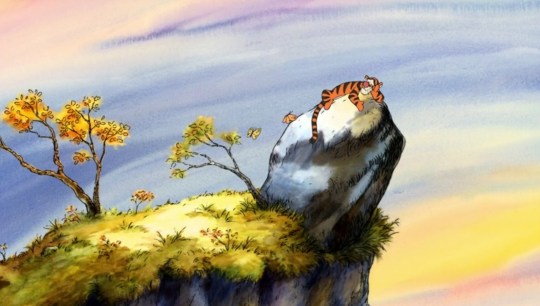
THE ONLY ONE
The Tigger Movie is pretty stunning because it centers around the deeper existentialism of the character Tigger. Tigger himself is the archetype for chaotically cheerful and energetic characters, a patron saint of upbeat innocent child-like arrogance, a source of optimism, he is the personification of BOUNCE as a word.
But the movie takes the concept of Tigger’s own theme song and tips it on its head. Tigger brags and boasts that the most wonderful thing about tiggers is that he’s the only one. But… is that truly wonderful? Of course it is, he’s wonderful and unique, but… he is the only one. Tigger’s own uniqueness puts him at odds with his more sedate friends who lack his energy, he’s an outsider. Tigger himself was introduced after the rest of the main cast, and as a result was not namechecked in the Winnie the Pooh theme until 2011’s Winnie the Pooh. Even in spite of being one of the most iconic characters from the series, he is still an outsider.
There is an innate sadness in the film through this investigation. The animation of Tigger through the emotional moments uses every line on his face to push his sadness to extremes especially considering that this is Tigger, the established energy ball of optimism. The movie is set in the liminal space of autumn’s change to winter, matching Tigger’s own orange and white palette and giving the whole film a warm, nostalgic glow, but this also allows the film to fully invest into the inevitability of change, and the loneliness of growing up.

FAMILY AND THE PAINS OF GROWING UP
Tigger waits in the snow for a letter that will never come, he walks through a snowstorm, the juxtaposition of Tigger in his height in the warmth of autumn against his low in the cold of winter makes his loneliness even more palpable.
The film’s theme is about family. Tigger wants to find his family - to find others like himself - but doesn’t recognise that he has a family in his friends. Roo looks up to Tigger and hangs to his every word, and wishes he was his little brother. Kanga and the others all decide to be the family that Tigger doesn’t have by pretending to be tiggers like him, their determination to make Tigger feel better supersedes their own preparations for winter.
But it’s also a coming of age story. Tigger grows up. He is exposed to some harsh truths throughout the narrative. He is the only tigger, his friends deceived him through good intentions, the idealised family tree he dreams of is fantasy, he feels the weight of his world on his shoulders… BUT… he is not alone. His friends all come together to remind him that they are always there for him through his highs and lows.

THE SUPERFICIAL vs. THE REALITY
The story also has a lot to say about superficial expectations vs. reality. In Tigger’s Dream Sequence Musical Sequence ‘Family Tree’, Tigger dips into the fantastical history of his imaginary family, which includes Tigger-themed pastiches on the Birth of Venus and other paintings, the Brady Bunch, Jackson 5, Don Quixote, a Marylin Monroe ‘Tiggerella’ Seven Year Inch-ing into the stratosphere from her billowing dress, and ultra-skinny supermodel Tiggers, replete with the Tigger lantern-jaw. The outlandish nature of this pop culture imagery amplifies how much of a superficial fantasy Tigger’s dream is and shows how out of place it is in the world Tigger inhabits.
The animals of the Hundred Acre Wood all try to come up with a plan to live up to this fantasy. In the song sequence ‘How To Be A Tigger’, the friends spend the first verses musing how to become Tigger to more superficial aspects of Tigger as a character. Upon reflecting, they realise that the reality of being Tigger is not in his stripes, his idiolect of ‘TTFN’s and ‘hoo-hoo-hoo-hoo!’s, or his dislike of eating honey, it’s in his ability to fill everyone with happiness with his cheery nature.
Tigger’s family tree itself fits this theme. After a conversation with Owl; Tigger, being naive and innocent, presumes that a family tree is a literal tree for the whole movie, rather than it being the metaphorical branching lineage that family trees actually are. In the final act, Tigger finds a tree striped with snow and determines that it’s his Family Tree, a location he should wait at for his real family.
The stripes on the tree, much like the tigger costumes his friends adorned and the ‘family heirloom’ locket, are superficial. But, in choosing it as his Family Tree, and Tigger using it as their shelter from the avalanche, the literal becomes the metaphor as the tree he chose as his family tree protects his friends, the family that he chose as well. The ‘family heirloom’ locket is also imbued with meaning through Tigger’s own determined attachment to it, and eventual use of it to store a picture of his ACTUAL family. Tigger chooses his family and the things that protect and represent them and I think the finding the meaning in the meaningless things by giving it to them yourself really fits the themes in the movie.
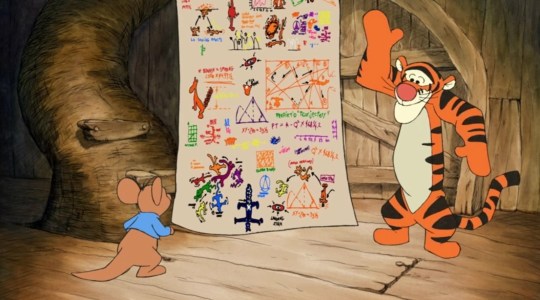
TO ANIMATE A TIGGER
The animation, of course, is wonderful to look at with the more discerning eye of adulthood. Going frame-by-frame through shots allows you to appreciate the artistry on show and understand what it was about it that captivated you as a child.
The rough photocopied line art of the original shorts is reflected in the animation and, much like Aardman’s stop motions having evidence of thumbprints, the imperfections add to the style and beauty. It’s through watching it in not-VHS quality that you notice that Tigger’s stripes have a strobing animation boil texture to them, where each frame has new linework shading of the stripes, which fills him with energy even in his more subtle scenes.
Tigger himself is a veritable powerhouse of animation. Frame by framing his movements, you can see him squash and stretch with every bounce and pounce. The largeness and looseness of his jaw allows for very fluid arcs to be created in his head.
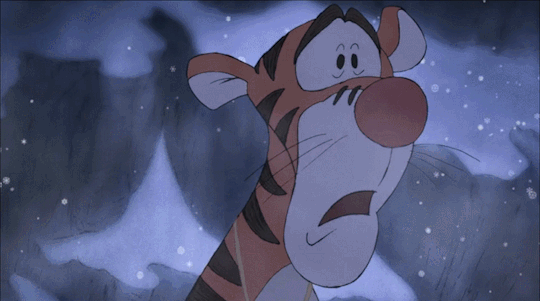
WHOOP-DE-DOOPER BOUNCE OF FAITH
In the final act, an argument between Tigger and his friends triggers an avalanche that threatens all of them. This sequence is the accumulation of the story, with the final scenes of the movie after it being the denouement resolution.
Tigger’s own self-centered search for his family immediately gets put to the side when his friends are in danger, leaping into action and helping his friends to the high branches of his tree. He even waits, arms outstretched to Rabbit, who had called his search for more Tiggers ‘nonsense’ and acted as a catalyst for his upset throughout the film. This puts Tigger’s positive nature on full display, he leaves no one behind, and this is in turn reflected outwards by Roo, who launches after Tigger as he gets swept away in the snow.
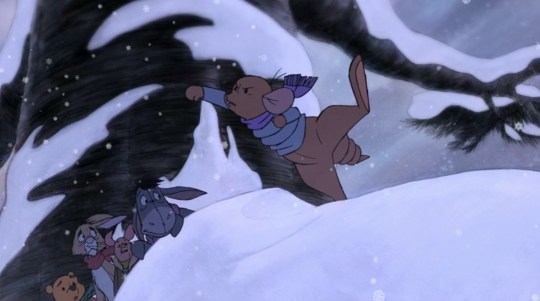
Throughout the movie, Roo idolises Tigger and wants to do anything to cheer him up, wanting him to be his big brother. Roo’s decisions and choices help drive the story alongside Tigger, and it’s a lot of his choices that end up building Tigger up for disappointment, but Roo is a child with stars in his eyes. He imitates him vocally and physically, and tries, and fails, to do the Whoop-de-Dooper bounce so that Tigger can have someone like him, tying back into the superficial against the reality. It is only when Roo acts on impulse with the determination to help someone in the same way as Tigger would that he succeeds at ‘being a Tigger’ and accomplishes the Whoop-de-Dooper bounce.
Similarly, Tigger doesn’t pay much attention to Roo, he enjoys his company but is looking too far beyond to see those who he already has as his family. But it’s when they both perform the Whoop-De-Dooper bounce in unison to escape danger and defy gravity that Tigger finally sees Roo properly.
After the avalanche, Tigger still looks beyond the horizon for more tiggers, but it’s when the other characters recite their letter that he is brought back to earth by being reminded of the family he chose. Tigger grows up, he realises he is The Only One, but that doesn’t mean he is without those who care about him and are his family.
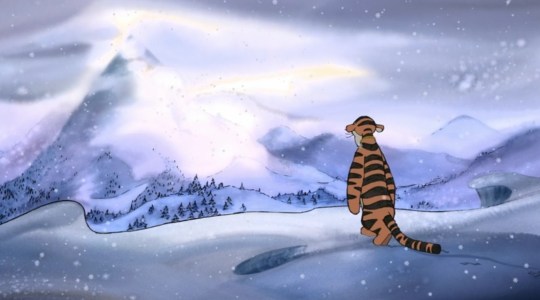
He grows past his innocently-self-absorbed mindset and comes to project his energy outwards in a more benevolent and less chaotic manner by providing his friends with winter supplies, and celebrating them. Roo especially. Tigger finally acknowledges him as his little brother, and gives him his ‘family heirloom’ locket. Both characters have grown and have fully realised who their family are.

OTHER NOTES
The movie also works visually to bring Tigger into the main cast so he is no longer an outsider. This film is the first one to my knowledge that shows Tigger’s house, a chaotically hoarded, sporty treehouse, compared to everyone else’s more subtle housing. Prior films in the Winnie the Pooh series had Tigger simply appearing and disappearing out of the blue, but now Tigger has an official location that is his own, like everyone else in the cast.
Pooh, quite rightfully, is often depicted to the extreme of ‘bear of very little brain’. And granted, there are still moments where Pooh falls for the tricks and gets lost sometimes, but in this movie, Pooh is actually quite cunning and devious. He sneaks up a tree to get some honey because he tells the others that they are potential Tigger family members. He is the character Roo goes to when Tigger goes into the snowstorm, and comes up with the expedition to find him. He also knows to get Rabbit to lead as ‘he’s the only one who ever says he knows what he’s doing’. I think the memory of Pooh usually paints him as more ditzy, but it’s nice being able to revisit and relearn that Pooh has an extra layer of emotional depth to him.
Tigger himself is portrayed as being significantly less ditzy than in other Pooh media. He’s not as ‘book smart’ as Owl or Rabbit, but Tigger figures out the exact point he should hit the boulder to make it move, he frisbees records so they land exactly on the pin, he is the inventor of the Whoop-de-Dooper Loop-de-Looper Alley-Ooper Bounce, if the expertise and diagrams suggest anything. Tigger isn’t always a chaotic whirlwind, there are hidden depths of precision. The character is allowed fairly mature growth beyond face value.
Rabbit yelling at the others, who are determined to present themselves as the Tigger family of Tigger’s dreams, for not preparing for the winter by saying ‘At least I haven’t forgotten what’s REALLY important’ got a very loud laugh out of me because it’s such a Rabbit line.
Whenever the book transitions to a new scene, it’s fun to pause and see the story of the film being written out in Milne-esque prose. It even includes the Emphasis Capitalsation to specific Important Things. More on the book, I like Tigger arguing with the storyteller at the start and changing the direction of the story through sheer tiggerific chaotic energy.
The songs are wonderful in this. The decision to give Tigger both an upbeat number (‘The Wonderful Thing About Tiggers’) and a downbeat number (‘Someone Like Me’) is genius. I like that, for his sad song, it is mostly just guitar and piano compared to the fully orchestral theme to emphasize his loneliness.
The songs that surrounded the film are great too. Kenny Loggins’ ‘Your Heart Will Lead You Home’ is one of those things that always gives me shivers from that rusty acoustic string reverb at the start. This is also the film that indirectly introduced me to ThirdEyeBlind’s ‘Semi-Charmed Life’ through the trailers of it.

CONCLUSION
The Tigger Movie will always hold a special place in my heart, and I am glad to have had the time to properly articulate how I feel about it. It is a film that I appreciate a lot more as an adult looking back, given its themes and the way the visuals capture them.
In some ways, in these uncertain times, I feel a bit like Tigger when he’s looking out with uncertainty over the horizon for more tiggers. It’s a lonely and uncertain visual as he looked out for What Comes Next.
And even with this movie acting as a blanket against the coldness of the real world, the moral of facing whatever’s next by protecting those who are your family, whether that’s the family you’re born into or the one you choose, will always be appropriate.
#the tigger movie#winnie the pooh#tigger#roo#disney#long post#thoughts#nostalgia#research#storytelling#essay
8 notes
·
View notes